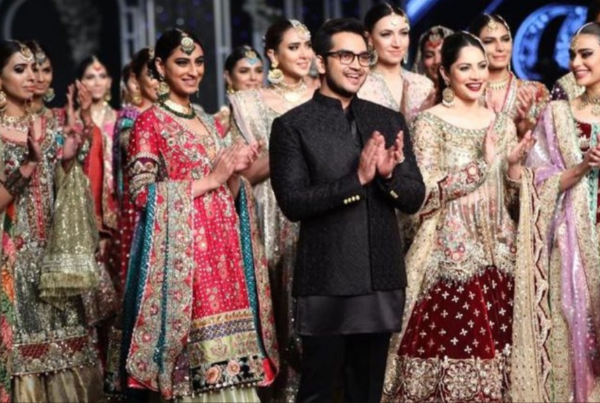The irony of these times is that the more we refine our means of communication – instant, wireless, long distance, inter-galactic, etc – the worse we are getting at communicating. We are losing our language to a new form of conversation called MSN and it’s doing no favours to the art, craft and romanticism of words.
“This is the state Urdu is in,†fashion designer Sonya Battla explained, pointing to her art piece from the recently held Karachi Biennale. Featuring three frames, woven together with scraps of castaway debris, the installation was originally dedicated to ‘Refugees’ but it applied just as effectively to the Urdu language, the designer explained. “Urdu is also enmeshed by different languages these days,†she said.
Touched by the subject, she designed a collection called Urdu and incorporated dying words instead of motifs in the designs. Sonya hosted a small gathering of linguists, including Subhan Nizami, Bari Mian, Zaheer Kidvai and Wajid Jawad, in her studio on Friday evening, hoping to get a conversation started on how to bring back the love for words.

Wajid Jawad, Subhan Nizami, Dr Hasan Azis, Bari Mian and Zaheer Kidvai brought back fond memories of the language that needs to be brought back.
“I speak Urdu very callously,†Sonya spoke for most of us. “I use Urdu as a means to an end, not like a form of art. Musharraf Faruqi and I had been talking about this for four or five years that we’ll do a collection. He wasn’t available right now so I decided to do it on my own. It just happened but it’s been on my mind for a very long time. Even when I watch TV I realize that we use language in the worse way possible. It’s used in a very harsh, non romantic way.â€
Sonya dedicated this collection to Urdu, incorporating words that are lost now in its warp and weave.
“Like ‘irtiqa’ is a word that we no longer use today,†she elaborated. There are so many words that are lost to time; it’s just to highlight that aspect. We don’t work on Urdu anymore. You have to work on things to keep them alive and evolving. They have to be worked on with love.

Aamna Haider Isani, Raania Durrani, Chris Hunt, Sonya Battla, Hala Syed and Talha Mufti
It’s this labour of love that the language is missing and also which fashion is missing in Pakistan these days. Fashion has become about speed and volume – how to sell generic products, in mass volumes, as quickly as possible – and very few people are stopping to think how their creativity can and should make a difference to society. Small yet significant initiatives like this are important in order to keep fashion relevant; it can’t always operate in a bubble.
The collection carried the Sonya Battla trademark of refined sophistication. It included cotton tunics embroidered with wide lined scrolls of random words; there were silk and velvet shirts embroidered with calligraphic motifs in Urdu. The collection’s palette was also signature Sonya Battla, incorporating a lot of black and white and ecru, and then evolving into colourful bursts of crimson red and indigo. Interestingly, portions of her boutique were divided by sheer black dupattas, embroidered with the same sense of script.
Fashion is utilitarian but it’s also an expression of one’s self, a collectible article of clothing that you acquire like a work of art and then wear as a statement. And when it comes to making statements, what better than one that helps express yourself better?
- This article was originally published in Instep, November 13, 2017





